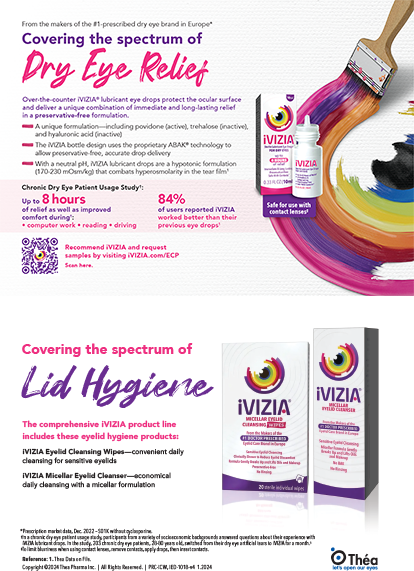QUESTION
An innocent cannula can become a dangerous missile capable of severe intraocular damage if it detaches under pressure during the injection of fluid or an ophthalmic viscosurgical device (OVD) (Figure 1). There are multiple reports of damage to both anterior and posterior segment structures. Are there any precautions that you or your staff take to prevent this occurrence?
JULIE TSAI, MD
During surgery, my surgical technicians are instructed to initially inspect the cannula attachments by retightening the hubs and injecting fluid or OVD through the cannula tip prior to handing the instruments to me. I, in turn, use a two-handed technique in which I grasp the instrument as well as the hub of the cannula. This maneuver allows me to steady the instrument as well as ensure that the cannula will not detach under pressure while I inject either fluid or an OVD.
BONNIE HENDERSON, MD
The cannula, if loosely placed, can cause irreparable damage to intraocular structures. The first important step of ensuring secure cannula placement on the syringe is staff education. Each staff member is taught the reason behind the secure attachment and the possible consequences of improper handling. Without the knowledge of what could happen, the staff member cannot thoroughly understand the purpose of the instructions.
In the second step, the staff member tests the cannula. Once the cannula has been placed, the fluid or OVD should be extruded out of the cannula to test the security of the connection.
The surgeon confirms that the cannula is securely placed on the syringe in the third step. Even with a well-trained staff, the ultimate responsibility of the safety of every single step lies with the surgeon. From the proper preparation of the instruments to setting the adjustments of the phacoemulsification machine, the surgeon must be vigilant and ensure that care has been taken to decrease any possibility of error.
RAMESH KODE, MD
Although loose or detached cannulas can be a dangerous complication with potentially disastrous results, there are some precautions that can be taken to minimize or reduce these types of occurrences. The first step is to educate and remind surgical staff of the importance of properly securing and tightening the cannula tips. I have actually demonstrated to our scrub technicians the velocity with which a loose cannula can be expelled if not properly secured.
In my case, I request that our scrub technicians secure the cannula tips tightly and also inject some fluid or OVD through the tips prior to passing the instrument to me. Once I receive the instrument, I manually tighten the cannula tip myself and gently inject fluid or OVD through the cannula before inserting it into the eye. If the cannula is loose, there may be weak flow of fluid or OVD from the tip, and/or there may be leakage of fluid or OVD at the base of the cannula attachment point. Once this is identified, the cannula can be tightened prior to inserting it into the eye. I take these precautions before injecting any type of fluid (trypan blue, hydrodissection/hydrodelineation) and with OVD use. I find that these extra precautions only take several seconds and definitely reduce the chance of detaching a loose cannula tip under pressure.
ROBERT H. OSHER, MD
I am obsessed with checking the tightness of the cannula, and at least once every few months, I manage to catch a cannula that has detached before it causes harm inside the eye. Since reporting two cases of iris damage,1 I go out of my way to educate the scrub technicians about the importance of securing the cannula and then test injecting it before they hand the syringe to me. Then, I will always hold the hub of the cannula between my left thumb and index finger before commencing the injection of either OVD or fluid. By pinching the hub, I can prevent damage should it inadvertently detach during forceful injection. If I have a choice between injecting through the main incision or through a side stab incision, I will choose the latter. Finally, when hydrating the incision, I try to embed the cannula's tip into the lateral border of the incision, which takes the sharpest portion of the cannula "out of play." An awareness of this dangerous complication is the first step in its prevention.
Section Editors Robert J. Cionni, MD; Michael E. Snyder, MD; and Robert H. Osher, MD, are cataract specialists at the Cincinnati Eye Institute in Ohio. They may be reached at (513) 984-5133; rcionni@cincinnatieye.com. Robert H. Osher, MD, is Professor of Ophthalmology at the University of Cincinnati and Medical Director Emeritus of the Cincinnati Eye Institute. Dr. Osher may be reached at (513) 984-5133; rhosher@cincinnatieye.com.
Julie Tsai, MD, is an Assistant Professor of Clinical Ophthalmology at the University of South Carolina. She may be reached at (803) 434-6836; jtsai@gw.mp.sc.edu.
Bonnie Henderson, MD, is an Assistant Clinical Professor of Ophthalmology at Harvard Medical School in Boston, Massachusetts. She may be reached at bahenderson@eyeboston.com.
Ramesh Kode, MD, is a cataract surgeon at the Cincinnati Eye Institute in Ohio. He may be reached at (513) 984-5133; rkode@cincinnatieye.com.


